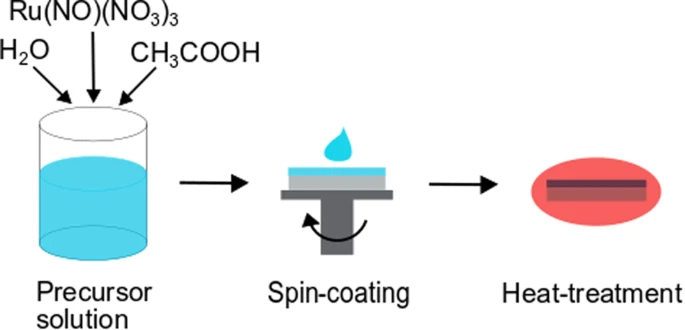Martina Angermann and co-workers have developed an effective method for depositing highly conductive thin films of ruthenium dioxide (RuO2) from aqueous chemical solution deposition. The method is not only simple and inexpensive, but also uses only environmentally friendly solvents (water and acetic acid) and could offer great advantages for industrial applications.

Conductive metal oxides such as RuO2 exhibit excellent thermal and chemical stability, which makes them attractive for a wide range of applications, from ferroelectric and magnetoresistive devices to solar cells, solid oxide fuel cells and sensors. In particular, RuO2 offers high conductivity and chemical stability, making it well suited as an electrode for (electro)catalysis (e.g. oxidation reactions, electrolysis,…), energy storage (supercapacitors, Li-ion batteries,…) and semiconductor devices.
Due to this wide range of applications, RuO2 thin films have already been prepared by a number of different techniques. Martina Angermann and colleagues have now shown that it is possible to deposit highly conductive RuO2 from a sol-gel solution using only water and acetic acid as solvents. The special features of this approach is that is flexible, cost-effective and environmentally friendly.
A critical factor in the process is the annealing temperature. The team showed that at an annealing temperature of 600 °C, it is possible to obtain dense and smooth thin films with a very low resistivity of 0.89 µΩm. The films show metallic character and are phase pure as confirmed by X-ray diffraction and Raman spectroscopy measurements. They also show good thermal stability up to 750°C.
In the context of the FOXES project, these results are an important step towards the realization of the supercapacitor used as an energy storage unit in the Power Cube, since RuO2 electrodes in capacitor structures reduce leakage currents and result in negligible fatigue and low retention losses compared to metal electrodes.
The results have been reported in the Journal of Sol-Gel Science and Technology.
Bibliographic Information:
Angermann, M., Jakopic, G., Prietl, C. et al. Highly conductive RuO2 thin films from novel facile aqueous chemical solution deposition. J Sol-Gel Sci Technol (2023).
https://doi.org/10.1007/s10971-023-06221-8
